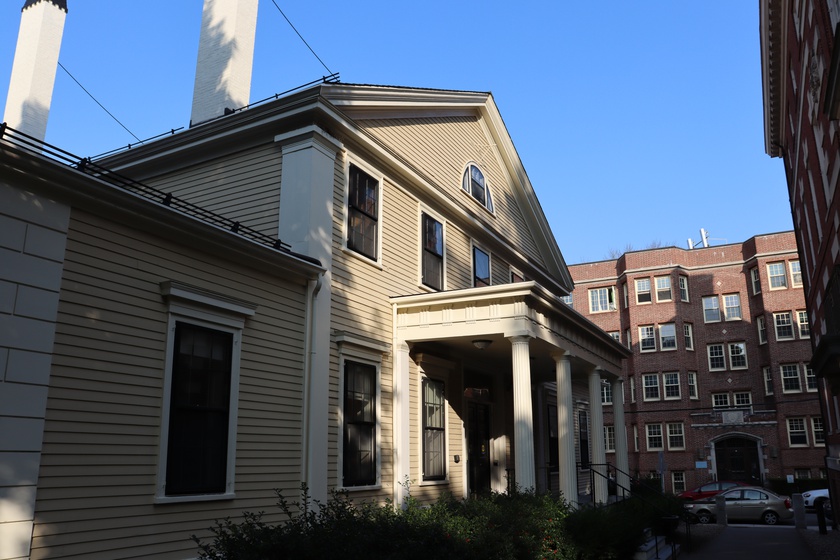{shortcode-3d149d70d5f138c11e75e58154c547ec74d104b4}
{shortcode-21cc3534b02e5a90dd1b6e61be0fe28423896a7e}cross from the humanities student hub, the Barker Center, sits a quaint yellow house — the historic Beck-Warren House, commonly referred to as simply the Warren House, home to Harvard University’s Folklore and Mythology and Celtic Languages and Literatures departments.
The Warren House has lived many lives. Harvard Latin professor Charles Beck built it in 1833, and Sanskrit scholar Henry Clarke Warren, Harvard College Class of 1879, owned and cared for the property from 1891 to 1899. In the 20th century, the building was owned by the President and Fellows of Harvard College and served as a philosophical library and home of the Harvard English Department.
{shortcode-d271b57e5bfa3d04fa4b693378c7ae467be32514}
{shortcode-61b9d34437ea5b5e5d06848a607275763cf96e94}
{shortcode-a5ef18bb9dc8295a37c91d72fad0bbcd489ce7d0}
Though most of the building has undergone minimal renovations, Warren’s 1891 half bath is remarkably well-preserved. This charming bathroom is located on the second floor in the Celtic Languages and Literatures Department. Taped to its entrance is a poster with a bent Celtic figure asking visitors to leave the door open when the bathroom is not in use.
{shortcode-8ee3b372956f09598eb98ec06d961a2bcce853db}
It sports an original marble basin, a toilet with a high tank pull chain, and a bathtub. The toilet was originally embellished with gold leaf. Glazed white ceramic covers the ceiling while brown tesserae coat the floor.
{shortcode-37bcf801305460158e052020179c157fce91a2d5}
Stella Lei ’26 discovered this curious half bath during a section for her course General Education 1097: “Tradition, Performance, Culture.” She immediately noticed “the big metal tub with the kind of weird shower head.” This zinc tub contains two shallow seats and centers around a showerhead with empty rings devoid of curtains.
“It kind of looks like a torture instrument,” Lei says. “There’s something creepy about it.”
{shortcode-7c5eda64a358f03b8c691e0e11239a263a6c6cfb}
Lei is not the only visitor who took note of the Warren House bathroom’s eerie dynamism. The 1981 mystery novel “Death in a Tenured Position” by Amanda Cross — a pseudonym of pioneering feminist academic Carolyn G. Heilbrun — opens with the discovery of a dead body in this very bathroom. The story retraces the mysterious death of Janet Mandelbaum, a recently tenured professor who is discovered at the end of the book to have committed suicide due to the ridicule she endured from her male colleagues.
{shortcode-cfeb001e87fbf94d33d8d9f82567f4100ed534e1}
{shortcode-84c42a906b2b43419932ff5625a47bac1094f848}
Heilbrun’s novel, which won the Nero Award the year it was published, deals explicitly with hierarchical and gendered structures within institutions of power. The Warren House of the late ’70s was an ideal setting for this sort of discussion because it housed the male-dominated Harvard English Department. By Heilbrun’s accounts, gender discrimination was pervasive within the undergraduate populations of elite institutions; she herself was the first woman to receive tenure in the English department at Columbia University.
“When I spoke up for women’s issues, I was made to feel unwelcome in my own department, kept off crucial committees, ridiculed, ignored,” Heilbrun told the New York Times in 1992. “Ironically, my name in the catalogue gave Columbia a reputation for encouraging feminist studies in modernism. Nothing could be further from the truth.”
A lot has changed since Heilbrun published “Death in a Tenured Position.” But her story records how fiercely women in the academy had to fight to defend their positions and recalls the legacy of exclusion in academic institutions.
Indeed, Warren House contains as much history as the departments that live there.
— Magazine writer Rose C. Giroux can be reached at rose.giroux@thecrimson.com.


